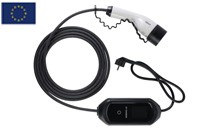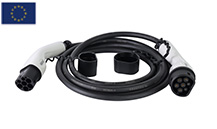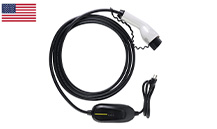EV charging cables often have two connectors, with one end connected to the vehicle end for charging and the other end connected to the charging infrastructure. It is now up to FAFA-E to introduce the two most common types of charging cables for EVs charging with AC power.
First is the Type 1 charging cable. The Type 1 connector with five pins is a standard American style connector that not only has no locking mechanism, but also supports only single phase charging. It is usually a 7KW single-phase device that supports this charging cable for charging, which is slower.
The Type 2 cable has a seven-pin connector, is a standard European-style connector, has a built-in locking mechanism, and supports three-phase charging.
Vehicle chargers, also known as EV portable chargers, are typically used for charging at home, work, and other locations, and use type 1 and type 2 charging cables more often.
AC charging power is low and charging time is long. And DC charging power is higher, so it is also called fast charging by the industry. So, do you know the types of charging cables that use DC power?
CCS combination charging connector is based on the type 2 connector with two additional pins, it is paired with a cable that allows more than 22KW of high power charging, home power does not support this cable charging, so it is commonly used in public charging stations or on the highway.
See many friends want to know how to choose EV charging cable?
Usually the choice is based on single-phase or three-phase power supply and vehicle charger.
Generally speaking for 3.7KW charging power, choosing single-phase 16A charging cable is enough; for 7.4KW charging station, choosing three-phase 32A cable is enough; for 22KW high power DC charging station, choosing three-phase 32A cable.
It is worth noting: if you choose three-phase power charging, then the charging station, charging cable, vehicle charger and other components must be three-phase, otherwise they will be incompatible and other problems will occur.
To choose the right cable for your electric car, you first need to check whether the type 1 or type 2 socket can accept the charging power of the vehicle. If your car is single-phase, it is recommended to use a single-phase charging cable; similarly, a three-phase vehicle needs to choose a three-phase cable with more charging power, which can shorten the charging time.
Home power supply is generally single-phase power supply, which can not be fast charging. Three-phase power supply is generally only compatible with CCS connector and CHAdeMO socket, and is suitable for fast charging station, the maximum charging power can reach more than 50KW.
The choice of three-phase or single-phase cable for load power should be based on the rated operating voltage of the load during normal operation. If the rated voltage of the load is three-phase 380V, choose a three-phase cable, and choose a single-phase cable if the rated voltage of the load during normal operation is single-phase 220V. Single-phase cables are more flexible compared to three-phase cables, but they are also heavier, generally twice as heavy as three-phase cables.
The choice of EV charging cable length depends on the distance between the charging infrastructure plug and the vehicle plug, and you can choose according to the actual situation.
FAFA-E offers European standard EV charging cables, American standard EV charging cables, and high power liquid-cooled charging cables. About us:https://www.fafa-e.com/






 简体中文
简体中文
